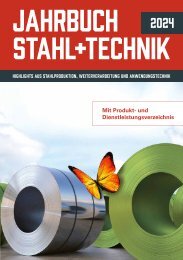STEEL + TECHNOLOGY 04/2019 EXTRACT
STEEL + TECHNOLOGY 04/2019 EXTRACT
STEEL + TECHNOLOGY 04/2019 EXTRACT
Create successful ePaper yourself
Turn your PDF publications into a flip-book with our unique Google optimized e-Paper software.
76 | <strong>STEEL</strong> PROCESSING<br />
Sawing instead of groove turning<br />
Ring cutting machine evolves into<br />
machining centre<br />
Dango & Dienenthal has developed a unique machine that separates huge sleeves into individual rings by<br />
sawing. Operation is faster and cheaper than grooving. The basic machine can be upgraded to a machining<br />
centre by attachments for turning, milling and drilling, and for ultrasonic testing.<br />
Dango & Dienenthal has developed its<br />
new RTM 30-8 ring cutting machine<br />
in cooperation with the German<br />
mechanical engineering company Klaaßen<br />
Maschinenbau GmbH. Compared to the<br />
conventional method, the sawing of ring<br />
sleeves has a number of benefits. So far,<br />
the sleeves used to be cut into rings by<br />
grooving on carrousel-type turning lathes.<br />
Due to the low cutting speed, the high tool<br />
wear and the necessity to repeatedly<br />
retract the chisel for the removal of chips,<br />
this was a rather time-consuming process.<br />
Additionally, the radial depth of cut – i.e.<br />
the maximum wall thickness of the sleeves<br />
– was limited to about 80 mm.<br />
Now, Dango & Dienenthal und Klaaßen<br />
have developed a new machine concept<br />
based on experience with a prototype<br />
machine. Fundamentally new about the<br />
system is that the individual rings are no<br />
longer cut by groove turning but by a sawing.<br />
The first full-scale machine is now in<br />
operation at Klaaßen.<br />
Sawing saves on material and<br />
enhances precision<br />
Sawing instead of turning provides material<br />
savings between 30 and 50 percent –<br />
especially when producing thin rings.<br />
Thanks to the extremely precisely operating<br />
circular saw, the thin blade and the<br />
excellent plane-parallelism of the cut pieces,<br />
machining allowances can be drastically<br />
reduced.<br />
Additionally, sawing reduces the cutting<br />
time dramatically – by up to 60% in case<br />
of steel rings and by up to 90% in case of<br />
high-strength materials such as titanium or<br />
nickel-based alloys. Also, non-productive<br />
times can be markedly reduced – by more<br />
than 40%, in case of six rings cut from a<br />
sleeve, for example.<br />
We enable our customers to manufacture rings<br />
on just one single machine, while in the past<br />
they usually needed three separate ones.<br />
Boris Marcukaitis, sales engineer at Dango & Dienenthal<br />
Further benefits of sawing over turning<br />
include: during sawing, the material in the<br />
kerf hardly increases in temperature, and<br />
a circular sawing blade – by nature –<br />
achieves a much better surface quality,<br />
resulting in a high plane-parallelism of the<br />
finished rings and practically totally dispensing<br />
with the need to rework the cut<br />
rings.<br />
Moreover, the service life of a circular<br />
saw blade is much longer than that of a<br />
grooving tool. Sawing is also much safer<br />
than grooving because it does not produce<br />
one single large chip but many small chips,<br />
which are removed from the kerf by the<br />
circular saw blade.<br />
A cutting machine serving as a<br />
machining centre<br />
RTM 30-8 ring cutting machine: clamped on the turntable the sleeve is cut by a circular<br />
saw (Picture: Dango & Dienenthal)<br />
Upgraded to a machining centre, the ring<br />
cutting machine provides a whole lot of<br />
additional benefits: Fitted with specific<br />
attachments – and without having to reclamp<br />
the work piece – it performs many<br />
<strong>STEEL</strong> + <strong>TECHNOLOGY</strong> 1 (<strong>2019</strong>) No. 4


















